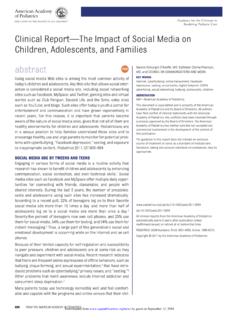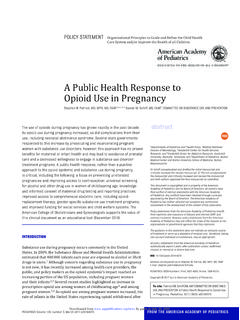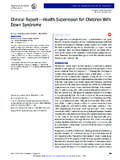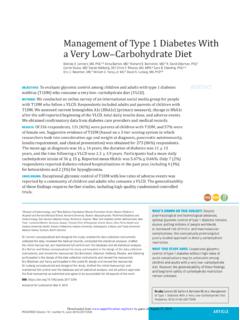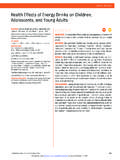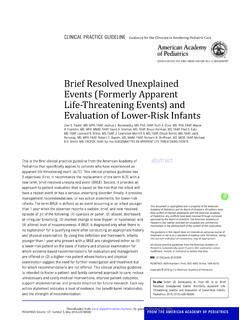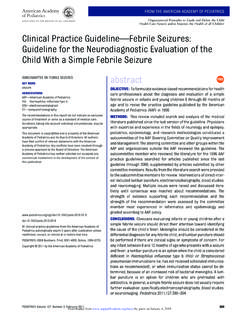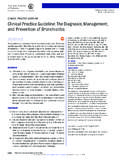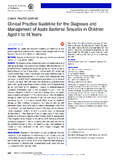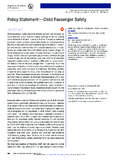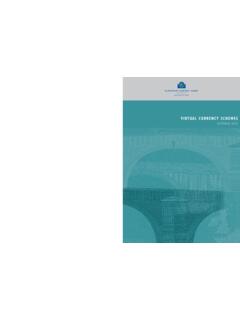Transcription of CLINICALPRACTICEGUIDELINE Diagnosis and Management of ...
1 CLINICAL PRACTICE GUIDELINE. Diagnosis and Management of Organizational Principles to Guide and De ne the Child Health Care System and/or Improve the Health of All Children Bronchiolitis Subcommittee on Diagnosis and Management of Bronchiolitis Endorsed by the American Academy of Family Physicians, the American College of Chest Physicians, and the American Thoracic Society. ABSTRACT. Bronchiolitis is a disorder most commonly caused in infants by viral lower respi- ratory tract infection. It is the most common lower respiratory infection in this age group. It is characterized by acute inflammation, edema, and necrosis of epithelial cells lining small airways, increased mucus production, and bronchospasm. The American Academy of Pediatrics convened a committee composed of primary care physicians and specialists in the fields of pulmonology, infectious disease, emergency medicine, epidemiology, and medical informatics. The com- mittee partnered with the Agency for Healthcare Research and Quality and the RTI.
2 International-University of North Carolina Evidence-Based Practice Center to develop a comprehensive review of the evidence-based literature related to the Diagnosis , Management , and prevention of bronchiolitis. The resulting evidence report and other sources of data were used to formulate clinical practice guideline recommendations. All clinical practice guidelines from the This guideline addresses the Diagnosis of bronchiolitis as well as various ther- American Academy of Pediatrics apeutic interventions including bronchodilators, corticosteroids, antiviral and an- automatically expire 5 years after tibacterial agents, hydration, chest physiotherapy, and oxygen. Recommendations publication unless reaf rmed, revised, or retired at or before that time. are made for prevention of respiratory syncytial virus infection with palivizumab The recommendations in this guideline and the control of nosocomial spread of infection. Decisions were made on the do not indicate an exclusive course of basis of a systematic grading of the quality of evidence and strength of recommen- treatment or serve as a standard of care.
3 Variations, taking into account individual dation. The clinical practice guideline underwent comprehensive peer review circumstances, may be appropriate. before it was approved by the American Academy of Pediatrics. Key Word This clinical practice guideline is not intended as a sole source of guidance in the bronchiolitis Management of children with bronchiolitis. Rather, it is intended to assist clini- Abbreviations cians in decision-making. It is not intended to replace clinical judgment or estab- CAM complementary and alternative medicine lish a protocol for the care of all children with this condition. These recommen- LRTI lower respiratory tract infection dations may not provide the only appropriate approach to the Management of AHRQ Agency for Healthcare Research and Quality children with bronchiolitis. RSV respiratory syncytial virus AAP American Academy of Pediatrics AAFP American Academy of Family Physicians RCT randomized, controlled trial INTRODUCTION CLD chronic neonatal lung disease THIS GUIDELINE EXAMINES the published evidence on Diagnosis and acute manage- SBI serious bacterial infection UTI urinary tract infection ment of the child with bronchiolitis in both outpatient and hospital settings, AOM acute otitis media including the roles of supportive therapy, oxygen, bronchodilators, antiinflamma- SpO2 oxyhemoglobin saturation LRTD lower respiratory tract disease tory agents, antibacterial agents, and antiviral agents and make recommendations PEDIATRICS (ISSN Numbers: Print, 0031-4005.)
4 To influence clinician behavior on the basis of the evidence. Methods of prevention Online, 1098-4275). Copyright 2006 by the American Academy of Pediatrics 1774 AMERICAN ACADEMY OF PEDIATRICS. Downloaded from by guest on November 11, 2019. are reviewed, as is the potential role of complementary acute illness, infants hospitalized with bronchiolitis are and alternative medicine (CAM). more likely to have respiratory problems as older chil- The goal of this guideline is to provide an evidence- dren, especially recurrent wheezing, compared with based approach to the Diagnosis , Management , and pre- those who did not have severe 15 Severe dis- vention of bronchiolitis in children from 1 month to 2 ease is characterized by persistently increased respiratory years of age. The guideline is intended for pediatricians, effort, apnea, or the need for intravenous hydration, family physicians, emergency medicine specialists, hos- supplemental oxygen, or mechanical ventilation.
5 It is pitalists, nurse practitioners, and physician assistants unclear whether severe viral illness early in life predis- who care for these children. The guideline does not poses children to develop recurrent wheezing or if in- apply to children with immunodeficiencies including fants who experience severe bronchiolitis have an un- HIV, organ or bone marrow transplants, or congenital derlying predisposition to recurrent wheezing. immunodeficiencies. Children with underlying respira- tory illnesses such as chronic neonatal lung disease METHODS. (CLD; also known as bronchopulmonary dysplasia) and To develop the clinical practice guideline on the diagno- those with significant congenital heart disease are ex- sis and Management of bronchiolitis, the American cluded from the sections on Management unless other- Academy of Pediatrics (AAP) convened the Subcommit- wise noted but are included in the discussion of preven- tee on Diagnosis and Management of Bronchiolitis with tion.
6 This guideline will not address long-term sequelae the support of the American Academy of Family Physi- of bronchiolitis, such as recurrent wheezing, which is a cians (AAFP), the American Thoracic Society, the Amer- field with distinct literature of its own. ican College of Chest Physicians, and the European Re- Bronchiolitis is a disorder most commonly caused in spiratory Society. The subcommittee was chaired by a infants by viral lower respiratory tract infection (LRTI). primary care pediatrician with expertise in clinical pul- It is the most common lower respiratory infection in this monology and included experts in the fields of general age group. It is characterized by acute inflammation, pediatrics, pulmonology, infectious disease, emergency edema and necrosis of epithelial cells lining small air- medicine, epidemiology, and medical informatics. All ways, increased mucus production, and bronchospasm. panel members reviewed the AAP Policy on Conflict of Signs and symptoms are typically rhinitis, tachypnea, Interest and Voluntary Disclosure and were given an wheezing, cough, crackles, use of accessory muscles, opportunity to declare any potential conflicts.
7 And/or nasal Many viruses cause the same con- The AAP and AAFP partnered with the AHRQ and the stellation of symptoms and signs. The most common RTI International-University of North Carolina Evi- etiology is the respiratory syncytial virus (RSV), with the dence-Based Practice Center (EPC) to develop an evi- highest incidence of RSV infection occurring between dence report, which served as a major source of infor- December and Ninety percent of children are mation for these practice guideline infected with RSV in the first 2 years of life,3 and up to Specific clinical questions addressed in the AHRQ evi- 40% of them will have lower respiratory ,5 dence report were the (1) effectiveness of diagnostic Infection with RSV does not grant permanent or long- tools for diagnosing bronchiolitis in infants and children, term immunity. Reinfections are common and may be (2) efficacy of pharmaceutical therapies for treatment of experienced throughout Other viruses identified as bronchiolitis, (3) role of prophylaxis in prevention of causing bronchiolitis are human metapneumovirus, in- bronchiolitis, and (4) cost-effectiveness of prophylaxis fluenza, adenovirus, and parainfluenza.
8 RSV infection for Management of bronchiolitis. EPC project staff leads to more than 90 000 hospitalizations annually. searched Medline, the Cochrane Collaboration, and the Mortality resulting from RSV has decreased from 4500 Health Economics Database. Additional articles were deaths annually in 1985 in the United States2,6 to an identified by review of reference lists of relevant articles estimated 510 RSV-associated deaths in 19976 and 390 and ongoing studies recommended by a technical expert in The cost of hospitalization for bronchiolitis in advisory group. To answer the question on Diagnosis , children less than 1 year old is estimated to be more than both prospective studies and randomized, controlled tri- $700 million per als (RCTs) were used. For questions related to treatment Several studies have shown a wide variation in how and prophylaxis in the AHRQ report, only RCTs were bronchiolitis is diagnosed and treated. Studies in the considered.
9 For the cost-effectiveness of prophylaxis, United States,9 Canada,10 and the Netherlands11 showed studies that used economic analysis were reviewed. For variations that correlated more with hospital or individ- all studies, key inclusion criteria included outcomes that ual preferences than with patient severity. In addition, were both clinically relevant and able to be abstracted. length of hospitalization in some countries averages Initially, 744 abstracts were identified for possible inclu- twice that of This variable pattern suggests a sion, of which 83 were retained for systematic review. lack of consensus among clinicians as to best practices. Results of the literature review were presented in evi- In addition to morbidity and mortality during the dence tables and published in the final evidence PEDIATRICS Volume 118, Number 4, October 2006 1775. Downloaded from by guest on November 11, 2019. An additional literature search of Medline and the all children with this condition.
10 These recommendations Cochrane Database of Systematic Reviews was per- may not provide the only appropriate approach to the formed in July 2004 by using search terms submitted by Management of children with bronchiolitis. the members of the Subcommittee on the Diagnosis and All AAP guidelines are reviewed every 5 years. Management of Bronchiolitis. The methodologic quality Definitions used in the guideline are: of the research was appraised by an epidemiologist be- Bronchiolitis: a disorder most commonly caused in fore consideration by the subcommittee. infants by viral LRTI; it is the most common lower The evidence-based approach to guideline develop- respiratory infection in this age group and is charac- ment requires that the evidence in support of a policy be terized by acute inflammation, edema and necrosis of identified, appraised, and summarized and that an ex- epithelial cells lining small airways, increased mucus plicit link between evidence and recommendations be production, and bronchospasm.
